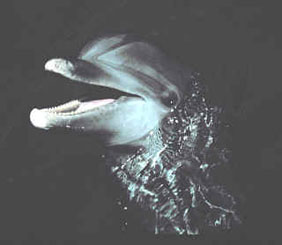Bottlenose Dolphin
Bottlenose Dolphin Sounds (Tursiops truncatus)
Description

Mother and juvenile bottlenose dolphins head to the seafloor. Photo courtesy of M. Herko, OAR/National Undersea Research Program (NURP).
These dolphins have short beaks called rostrums. Their bodies are gray or charcoal in color with a lighter underside. They can grow to about 3.9 m (13 ft) in length. Bottlenose dolphins are very widespread and commonly found in the Atlantic, Pacific, and Indian Oceans and the Mediterranean Sea. They are distributed close to shore and in deep offshore waters. Bottlenose dolphins are often seen in groups of 5-40 individuals, but they can also be found alone or in pairs or trios. Bottlenose dolphins produce a large number of vocalizations, including whistles, buzzes, quacks, pops, rusty hinged sounds, yelps, and clicks. They communicate with whistle vocalizations and find a wide variety of prey by echolocation, a series of high frequency clicks (about 110-130 kHz). These dolphins are capable of combining the echolocation clicks into short series or elaborate trains of sound (see How do marine mammals use sound when feeding?). Individually distinctive signature whistles are thought to be used to broadcast the identity and location of the calling animal in a group (see Individual-specific vocalizations)

Close-up of bottlenose dolphin. Photo courtesy of NOAA Fisheries.
Additional Resources
- American Cetacean Society Fact Sheet: Bottlenose dolphins.
- National Marine Mammal Laboratory: Bottlenose dolphins .
- Scripps Institution of Oceanography, Voices in the Sea
References
- Buck, J. R., Morgenbesser, H. B., & Tyack, P. L. (2000). Synthesis and modification of the whistles of the bottlenose dolphin, Tursiops truncatus. The Journal of the Acoustical Society of America, 108(1), 407–416. https://doi.org/10.1121/1.429474
- Connor, R., & Whitehead, H. (2005). Alliances II. Rates of encounter during resource utilization: a general model of intrasexual alliance formation in fission–fusion societies. Animal Behaviour, 69(1), 127–132. https://doi.org/10.1016/j.anbehav.2004.02.022
- Finneran, J. J., Oliver, C. W., Schaefer, K. M., & Ridgway, S. H. (2000). Source levels and estimated yellowfin tuna ( Thunnus albacares ) detection ranges for dolphin jaw pops, breaches, and tail slaps. The Journal of the Acoustical Society of America, 107(1), 649–656. https://doi.org/10.1121/1.428330
- Richardson, W. J., Green, C. R., Malme, C. I. J., & Thomson, D. H. (1995). Marine Mammals and Noise. San Diego: Academic Press.
- Whitehead, H., & Connor, R. (2005). Alliances I. How large should alliances be? Animal Behaviour, 69(1), 117–126. https://doi.org/10.1016/j.anbehav.2004.02.021